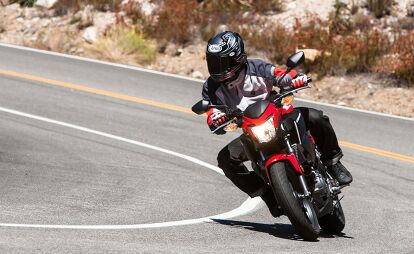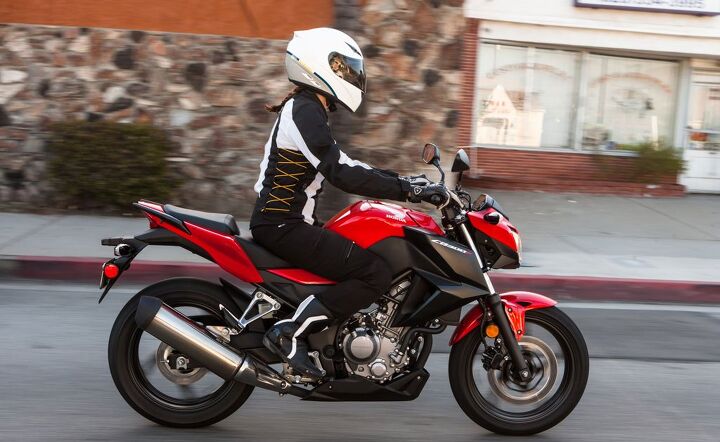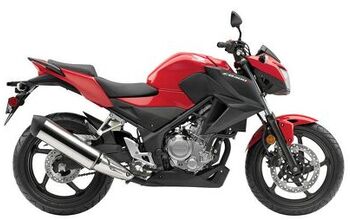2015 Honda CB300F Review

Honda's latest beginner bike takes off some clothes
When we were introduced to the 2015 Honda CBR300R at its recent press introduction at Honda’s headquarters in Southern California, Honda reps teased us by displaying the 300R’s naked sibling, the CB300F, alongside it. We weren’t able to ride it, but there it sat, ready for the assembled press to sit, ogle and stare. Thankfully, Honda didn’t keep us waiting for long, as only weeks after I rode the fully faired 300R, we were given a 300F to throw around.
Less Is More
2015 Honda CB300F
| Engine | 18.0/20 |
| Suspension/Handling | 11.5/15 |
| Transmission/Clutch | 8.0/10 |
| Brakes | 7.0/10 |
| Instruments/Controls | 4.0/5 |
| Ergonomics/Comfort | 9.0/10 |
| Appearance/Quality | 8.0/10 |
| Desirability | 8.0/10 |
| Value | 9.5/10 |
| Overall Score | 83/100 |
Judging the CB300F and CBR300R based on outward appearance really does reveal the difference between the two. Start with the latter, shed nearly all of the bodywork ahead of the engine, ditch the dual headlights for a single lamp, then swap the clip-ons for a handlebar and you’ve got the former. Otherwise, the two bikes are identical.
2015 Honda CBR300R First Ride Review
That is to say the 300F shares the same frame, wheels, brakes, tires and suspension as the 300R. Of course, both bikes also have the liquid-cooled, 286cc counterbalanced Single in common, too. Itself being simply a stroked version of the 249cc DOHC, four-valve engine first seen in yesteryear’s CBR250R. For full details on the CBR300R, click the link above to read all about it.
Honda claimed a 17% increase in power over its predecessor, and after running our 300F on the MotoGP Werks dyno in Anaheim, California, those claims appear to be spot-on. With 26.2 horses at 8500 rpm, our test bike put out exactly 17% more power than the last CBR250R we tested (22.5 hp). Torque output is 17.4 ft-lbs at 6800 rpm. Not mind blowing, but respectable in the class and also 17% greater than the 250R.
“My first ride aboard the CB300F awakened me to the fact that the little Honda has considerably more oomph compared to the bikes against which we were testing in our forthcoming Lightweight Nakeds shootout,” says Content Editor, Tom Roderick.
When all is said and done, the 300F comes in 9 lbs lighter than the R model and also sheds some weight on price. Starting at $3999, it’s $400 cheaper than the R.
From The Saddle
As one would expect, riding the CB300F isn’t too dissimilar from the CBR300R. The obvious difference being the amount of forward tilt the rider experiences. While the 300R has the rider slightly hunched forward to grab the clip-ons, the 300F’s pilot is greeted to a much more neutral position thanks to the upright bars.
One of the nice aspects of the single-cylinder engine, especially for newer riders, is its narrow dimensions. This helps keep the rider’s legs from splaying too far apart once on the bike, and though the 300F’s 30.7-inch seat height is modest, the narrowness of the seat/gas tank junction aids shorter riders in planting both feet on the ground. For reference, my 30-inch inseam had no issues firmly getting both hoofs on tarmac.
Clutch pull is light, which should give the newer rider more confidence while leaving a stop. Most of our testers judged the Honda’s fueling to be fault-free, but kickstart-editor, John Burns, felt a slight hiccup during on/off throttle application. The shift lever easily moves from gear to gear, meaning its not only easy to pull away from a stop, but shifting as you pick up speed is simple, as well.
With more power and torque than the 250R, gaining forward momentum is done more briskly than before. Now that the 300F has more guts, merging with freeway traffic is less fear-inducing than we’ve experienced on other small-displacement bikes, including the 250R. There’s even a respectable amount of passing power in reserve, too, as the 300F will flirt with 90-plus mph if given enough room.
All the while, we were impressed at the relative lack of vibration from the engine. Singles are known to rumble at high engine speeds, but Honda has done a commendable job quelling vibes on the 300F. Vibes are really only felt once pushing past 80 mph, and are noticed more in the pegs than the bars. Keep speeds modest, and she’s virtually vibe-free.
Handling from the CB is neutral, as the bars provide good leverage to flick from one direction to the next. The 37mm fork and preload-adjustable shock are dialed on the soft side. So, backroad bombing isn’t its specialty, but the rider who emphasizes smoothness over aggression will be rewarded with a pleasant experience.
About the only thing we could fault from the CB300F are its brakes. Equipped with a 296mm disc in front and 220mm disc in the rear, stopping performance was merely adequate. While certainly not bad, our particular test bike had a spongy lever, which I don’t remember from the CBR300R. Some new pads and steel-braided lines would likely go a long way towards dramatically improving the 300’s stopping power.
Naked Learners
From practically the beginning of time, whenever we’ve been asked what bike a new rider should start on, we almost always side with the baby Ninja or CBR. However, those days might be coming to an end. With the CB300F, riders will get all the performance the fully-faired versions carry, with some added benefits.
First, handlebars instead of clip-ons are more comfortable for normal riding, and they make it slightly easier for riders to learn tight, slow-speed maneuvers. Second, the 300F costs less than the CBR (and Ninja 300). Third, and more importantly, the lack of bodywork means the inevitable tipover won’t have as severe a consequence. Factor in the ease of maintenance from the lack of bodywork, and the CB300F draws a strong case for itself as the prime starter bike.
Experienced riders will also find the 300F a fun bike. Its relative lack of power will keep them out of trouble while simultaneously serving as a great learning tool for instilling proper technique to maintain speed. Also, take into account the nearly 60 mpg we returned from our test unit, and riders of all experience levels should find the CB300F appealing for the daily grind.
+ Highs
- More comfortable than the 300R
- Cheaper, too!
- Maybe the perfect motorcycle for the new rider
– Sighs
- Mushy brakes
- Uh …
- Bueller?

Troy's been riding motorcycles and writing about them since 2006, getting his start at Rider Magazine. From there, he moved to Sport Rider Magazine before finally landing at Motorcycle.com in 2011. A lifelong gearhead who didn't fully immerse himself in motorcycles until his teenage years, Troy's interests have always been in technology, performance, and going fast. Naturally, racing was the perfect avenue to combine all three. Troy has been racing nearly as long as he's been riding and has competed at the AMA national level. He's also won multiple club races throughout the country, culminating in a Utah Sport Bike Association championship in 2011. He has been invited as a guest instructor for the Yamaha Champions Riding School, and when he's not out riding, he's either wrenching on bikes or watching MotoGP.
More by Troy Siahaan





































Comments
Join the conversation
Thanks for the review. I'm completely new and I think this will be my first bike. Doesn't sound like I'll regret it one bit.
that is not a beginner motorcycle. unfortunate that ABS is not included....